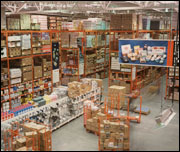Cell phones that do email, take photos and surf the web. Cars with options ranging from satellite radio to rain-sensing wiper blades. Wireless fabric keyboards that roll up and stow in your pocket. Not a day goes by without a new product roll-out — or the unveiling of a spruced-up, old product that’s more powerful, convenient or easier to use.
While a boon for consumers, these millions of new products appearing regularly make inventory management as dicey as predicting what a teenager will want for her birthday next year. “No one knows what demand for these things will be,” says Wharton operations and information management professor Serguei Netessine. Yet with product life cycles becoming increasingly short, he notes, supply chain management has become more important than ever. Netessine points to the computer and automotive industries as examples. “Just think how years ago, the Ford Model-T came in one color: black. Now look at how many models and options there are — millions for the same car. How do you forecast the number of cars to build? If you look at the computer industry, you have new and improved memory chips and new processors coming out several times a year.”
Clearly, managing inventory levels has become highly complex — and crucial to a company’s survival. If you keep too much inventory, your expenses go up. “But if you reduce too much, you have nothing to sell,” Netessine says. Despite the critical role inventory management plays in a company’s success, however, no one knows how to measure the quality of supply chain management. “Everyone knows that Dell and Wal-Mart are good, but beyond that it is hard to tell if one company is better than the other in its supply chain management.”
In joint research with Wharton doctoral student Serguei Roumiantsev, Netessine set out to find a true quality measure. The result is “a statistical methodology that links managerial decisions related to inventory with accounting returns,” the authors note in their new report entitled, “Should Inventory Policy Be Lean or Responsive? Evidence for U.S. Public Companies.”
Slim Isn’t In
One of the biggest surprises Roumiantsev and Netessine found is that running a lean inventory operation is not necessarily associated with a better bottom line. “Inventory levels alone do not have a significant and negative relation to current or future profitability,” they report. “In fact, in some industries the more inventory you hold, the more profitable you are,” says Roumiantsev.
What does affect a company’s profitability, however, is how quickly management adjusts inventory to meet changes in the marketplace. “Superior earnings are associated with the speed of change/responsiveness in inventory management,” the authors write. In other words, companies that increase inventory levels swiftly to meet greater demand or decrease levels when demand slackens are more profitable.
These findings seem to support “Just In Time” manufacturing techniques, which emphasize maintaining minimal inventory levels by ordering materials as close as possible to the actual time of need. However, Netessine’s research shifts the emphasis away from keeping inventory lean and places more importance on speed. “I don’t think our research is inconsistent with Just In Time, which is about quickly adjusting your inventory,” he says. “But people didn’t know how to measure that using publicly available financial data.”
Measuring Inventory Responsiveness
In their study, Netessine and Roumiantsev analyzed data from 722 public companies representing eight industries: oil and gas, consumer electronics, wholesale, retail, machinery, computer hardware, food and beverages, and chemicals. “We use quarterly data containing 44 time points between 1992 and 2002 for every company in our sample,” the researchers write. No service businesses were included in the sample, since inventories are less relevant for such companies. They also excluded conglomerates, like General Electric, in which operations were too diverse to break down. On average, companies in the sample held $396 million of inventory and had quarterly sales revenues of $572 million.
“We first tried to find out what explains how much inventory a company holds,” says Netessine. “Why does this company have this amount and that company a different amount, even when they are in the same industry?” The biggest determinants of inventory levels were average demand, the uncertainty of demand, lead times and cost of capital. “If you are sourcing from Asia, you should have more inventory,” says Netessine. “If capital is more expensive, you should have less. All of these factors together explain how much inventory a company holds.”
Then Netessine and Roumiantsev looked at how quickly a company adjusted its level of inventory in response to changes in the environment. To establish a company’s inventory responsiveness — called “elasticity” of inventory — they measured the speed of change in inventory with respect to lead time, sales, sales uncertainty and gross margin. “Then we looked at changes in those factors from quarter to quarter and how inventory changes from quarter to quarter,” says Netessine. “Elasticity, for example, measures a change in inventory associated with a 1% change in demand. It shows how quickly a company can adjust inventory relative to other environmental variables.”
Finally, they looked at the impact of inventory management on a company’s return on assets (ROA), as a measure of financial performance. The results: “Companies that react faster (have greater elasticity) to sales, demand uncertainty and lead time by adjusting inventories do, on average, have higher ROA.” This was true not only for current ROA but also for future ROA, projected out three and six months.
Results of specific industries showed more variation. For instance, the ability to source faster had a stronger impact on ROA in the retailing and electronics segments. Not surprisingly, the study also found that companies in industries where demand is less certain on average are less profitable. “We suggest that more detailed segment-specific analysis be performed on a less aggregated data sample to study specific industries,” the authors write.
A Proxy for Quality
A possible outcome of the study is that it could help investors better predict the financial performance of companies. “Due to limited understanding of the connection between inventory management and financial performance, few analysts and fund managers use inventories to predict/explain superior accounting returns,” the report states. However, authors note one exception — David Berman, a hedge fund manager in the retailing sector who, by paying particular attention to the “joint dynamics of inventory and sales,” achieved remarkable performance for his portfolio. (His methodology is described in a recent Harvard Business School case study called “David Berman”.) Roumiantsev, however, stresses that inventory elasticity alone can’t explain stock performance, and “more research is needed to link [them].”
A more obvious and important outcome of the study is that it provides a way to measure a company’s ability to manage inventory. Looking at companies’ “inventory elasticity,” the report concludes, is a more relevant measure of operational excellence than simply looking at inventory levels. Indeed, it is common practice for companies to manipulate inventory levels by delaying acceptance of shipments or offering discounts to temporarily decrease inventory levels. “We would like to suggest that it is harder to manipulate inventory elasticities that may provide a fuller picture of the situation,” reports Netessine. “By analyzing a firm’s response to the environment in terms of inventory adjustments, boards of directors might be able to better evaluate the management of a company.”
This is something that Wal-Mart already has recognized. “Wal-Mart is clearly looking at how inventory tracks sales,” says Netessine. In fact, in its 2004 annual report, the company notes, “Inventory growth at a rate less than half of sales growth is a key measure of our efficiency.”
In running their elasticity to profitability model, Netessine and Roumiantsev found that Wal-Mart was not among the leanest retailers in terms of levels of inventory. “However, it has been very successful in responding quickly to environmental variables” and came out in the top 25% of companies in terms of inventory elasticity with respect to sales. Kmart, on the other hand, held similar levels of inventory but was “sluggish in terms of the speed of inventory management.” As Netessine concludes, “The most sophisticated companies in supply chain management realize that responsiveness in inventory management is important.”
Should inventory policy be lean or responsive?



